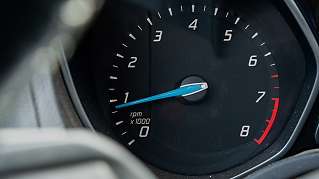







Eco-driving is a style of driving that prioritises maximising fuel efficiency and minimising CO2 emissions. Eco-driving shouldn’t be confused with eco mode, a technological feature in modern vehicles designed to improve energy efficiency. This guide is an essential resource for fleet managers. It outlines the environmental and economic benefits of eco-driving, introducing nine key driving practices that promote efficiency and sustainability.
What is eco-driving and how does it benefit fleets?
Eco-driving is a type of driving that intends to reduce CO2 emissions and prevent the overconsumption of fuel. Implementing this driving style offers fleets three key benefits.
Reduced costs
Adopting fuel-efficient driving practices can reduce your fleet’s fuel consumption by up to 15%. Driving behaviours like speed, idling and acceleration impact your fleet’s total fuel spend. They can also influence your insurance premiums: Fuel-efficient vehicle speeds are safer, meaning fewer likely accidents. Eco-driving produces less wear and tear on your vehicles, helping you save on repair maintenance costs.


Lower CO2 emissions
The type of fuel your vehicles use can determine how much CO2 emissions you save with eco-driving. Generally, the CO2 output for diesel is higher than petrol and LPG. With that said, ecological driving behaviours do contribute to lower fleet emissions. Especially when driver coaching comes into play. According to Fleet Europe, eco-driving training on average results in long-term fuel savings of 6%. That adds up to significant savings on your fuel spend as well as your CO2 output.
Decreased risk of accidents
As noted by Fleet Driver Training, eco-driving enhances safety by strengthening focus and anticipation. Because it’s highly anticipatory, helping drivers perform with alertness and caution, ecological driving tends to eliminate some behind-the-wheel stress. By travelling at slower speeds, drivers have more reaction time for braking or switching lanes when needed. All of this adds up to a decreased risk of incidents on the road.

Top 9 eco-driving practices for fleets
The UK government is striving to reduce emissions by roughly 80% by 2035, reaching net zero by 2050. This makes eco-driving an imperative for fleets, which face increasingly strict compliance standards. Here are nine considerations to help your fleet adopt eco-driving.
Cold start
The likelihood for the overconsumption of fuel is highest after a vehicle has just started. When an engine is still cold, a vehicle driving through an urban area can consume 45% more fuel on the first kilometre and 25% on the second kilometre. Save fuel by driving at a moderate speed and accelerating gently for the first five kilometres. It’s not necessary to let the engine run to "warm it up," as that only increases fuel consumption.


Engine speed
Gear shifting can make a difference in how efficiently your engines run. We recommend shifting gears at the optimal revolutions per minute (RPM):
- 1200 to 1500 RPM for diesel engines
- 2000 to 2500 RPM for petrol engines
When driving above 40mph, it’s more fuel-efficient to shift into a higher gear.
Acceleration
Smooth acceleration is an effective fuel-saving tactic. It requires pressing moderately on the accelerator pedal when starting a vehicle or speeding up. Conversely, aggressive driving (rapid acceleration, sharp turns, frequent lane changes, etc.) guzzles fuel and increases the risk of accidents.


Engine braking
Engine braking is the process of slowing down a vehicle by releasing the accelerator and downshifting rather than stepping on the brake pedal. This form of “braking” can help save fuel. Relying less on the brake pedal also extends the life of your brake pads and emits fewer toxic particles.
Speed regulation
Maintaining a constant speed is another way to reduce fuel consumption. On highways, activate cruise control when it’s safe and appropriate to do so. Regulating speed will improve your fleet’s overall fuel efficiency, reducing costs as well as emissions.


Idling
A vehicle at standstill consumes between 0.5 and 1 litre of fuel per hour. When your fleet vehicles are running but stopped for more than 30 seconds, turning off the ignition prevents wasting fuel.
Tyre inflation
Properly inflated tyres are essential to eco-driving. Internal data from the Bridgestone group shows that an underinflation of ±2 bars for all tyres on a heavy vehicle:
- increases fuel consumption by up to 2.5%
- reduces the lifespan of tyres by 25%
- limits the possibility of retreading
- can result in tyre failure
Tyres naturally deflate by about 0.3 bar on average per month. With a Tyre Pressure Monitoring System, you can optimise fuel efficiency and eco-driving.


Air conditioning
Air conditioning can increase your fuel consumption significantly, with a 10% spike on highways and a 25% jump in built-up areas. Cooling down a vehicle can be as simple as parking in the shade. If it’s necessary to use the air conditioner, open the windows to evacuate the heat first, and don’t cool the vehicle more than five degrees less than the outside temperature.
Vehicle maintenance
A poorly maintained vehicle can consume 10% more in fuel than one that is well maintained. So, there’s a link between regular vehicle maintenance and fleet sustainability. Regularly changing the oil and air filters keeps engines in optimal condition.

How to empower drivers to adopt fuel-saving techniques
Adopting a fuel-saving driving style across your fleet requires patience and collaboration, but the reductions in cost and environmental impact make the effort well worth it. Engaging drivers through training and recognising their contributions to fuel efficiency are key steps in this process.
Coaching and training:
With a performance tool like OptiDrive 360, you can analyse fuel consumption patterns historically and in real time, making it easy to determine whether driver training could improve fuel efficiency. You can also empower drivers with real-time feedback, enabling them to adjust their driving performance in the moment.


Incentive programmes:
Demonstrating appreciation for drivers who successfully reduce fuel consumption can motivate the entire fleet. Acknowledge and reward drivers who meet fuel-saving criteria, enhancing their commitment to eco-driving practices.
Optimised planning:
Traffic congestion significantly increases fuel consumption due to idling. Help drivers avoid traffic jams with optimised route planning, utilising reliable GPS and up-to-date traffic information to save on fuel and reduce idling time.


Regard them as valued stakeholders:
Drivers play a crucial role in your fleet's success. Involve them in discussions about fuel efficiency, valuing their insights and suggestions. Their daily experiences can offer valuable perspectives on improving driving behaviours and reducing in-cab power use.
Integrating eco-driving into your fleet management strategy
Looking for more advice on adopting eco-driving to enhance fleet efficiency and sustainability? Take advantage of Webfleet’s 25-plus years of expertise and request a free consultation with us.






Your consent is required
In this section, external content is being embedded from .
To display the content, your consent is required for the following cookie categories:
- Targeted Advertising
- Analytics & Personalization
- Essential
For further details, please refer to our privacy policy. If you are interested in how ###vendor_name### processes your data, please visit their privacy policy.








